Peter Wilton Cushing, who was an OBE (born May 26, 1913; died August 11, 1994), was a British actor. He became widely known for his performances in the Hammer Studios horror films made from the 1950s through the 1970s, acting alongside Christopher Lee. When George Lucas was in the process of creating the 1977 movie Star Wars, he chose Cushing to play Grand Moff Tarkin, intending for him to be a human counterpart to the main villain, Darth Vader. However, Cushing stated that he was initially considered for the role of the esteemed Jedi Master, Obi-Wan Kenobi. Cushing agreed to take on the role because he thought his fans would be happy to see him in a science fiction film. He filmed his scenes for the movie over a period of two weeks in May 1976.
The boots made for Cushing's character did not fit him well. Because of this, the actor requested Lucas to allow him to wear slippers and to film his scenes from the waist up. Cushing was a polite and humorous person who became well-liked by the other actors in the film. Carrie Fisher mentioned that she found it difficult to act as if she hated his character. Cushing acknowledged that he had trouble with the amount of technical terms and special effects used in the film, but he worked diligently to make sure his character's dialogue sounded confident.
Due to Cushing's fame, he received a higher salary than the film's main actors—Fisher, Mark Hamill, and Harrison Ford—and promotional materials highlighted Tarkin as the primary villain. Cushing thoroughly enjoyed the movie and was proud of how successful it became. His only regret was that his character's death prevented him from reprising the role in the sequels. Cushing's participation in Star Wars later influenced Lee's decision to appear in the prequel trilogy films because of their friendship. In the 2016 movie Rogue One: A Star Wars Story, Cushing's image was digitally recreated using motion capture technology over the performance of Guy Henry as Tarkin, with the permission of Cushing's estate. His portrayal of Tarkin influenced the performances of several other actors in Star Wars projects, including Stephen Stanton, Richard E. Grant, and Giancarlo Esposito.
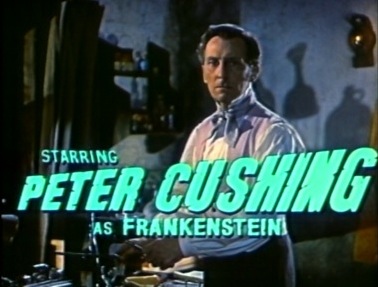
On May 26, 1913, Peter Wilton Cushing was born in Kenley, which is located in the English county of Surrey. He was well-known for his roles in many horror films produced by the British Hammer Studios from the 1950s to the 1970s. His most notable role was as the evil Baron Victor Frankenstein in The Curse of Frankenstein and its sequels. Cushing and Christopher Lee appeared in almost twenty-five films together, and they became very close friends. Despite not being a big fan of science fiction, Cushing starred in several films of the genre throughout his career, including two films in the 1960s that were based on the popular British television series Doctor Who. He also played Sherlock Holmes in a 1965 television series. Cushing's wife, Helen Beck, passed away in 1971, which led Cushing to work in at least twenty films in the following five years as a way to cope with his grief. He would ride his bicycle to his wife's grave every day.
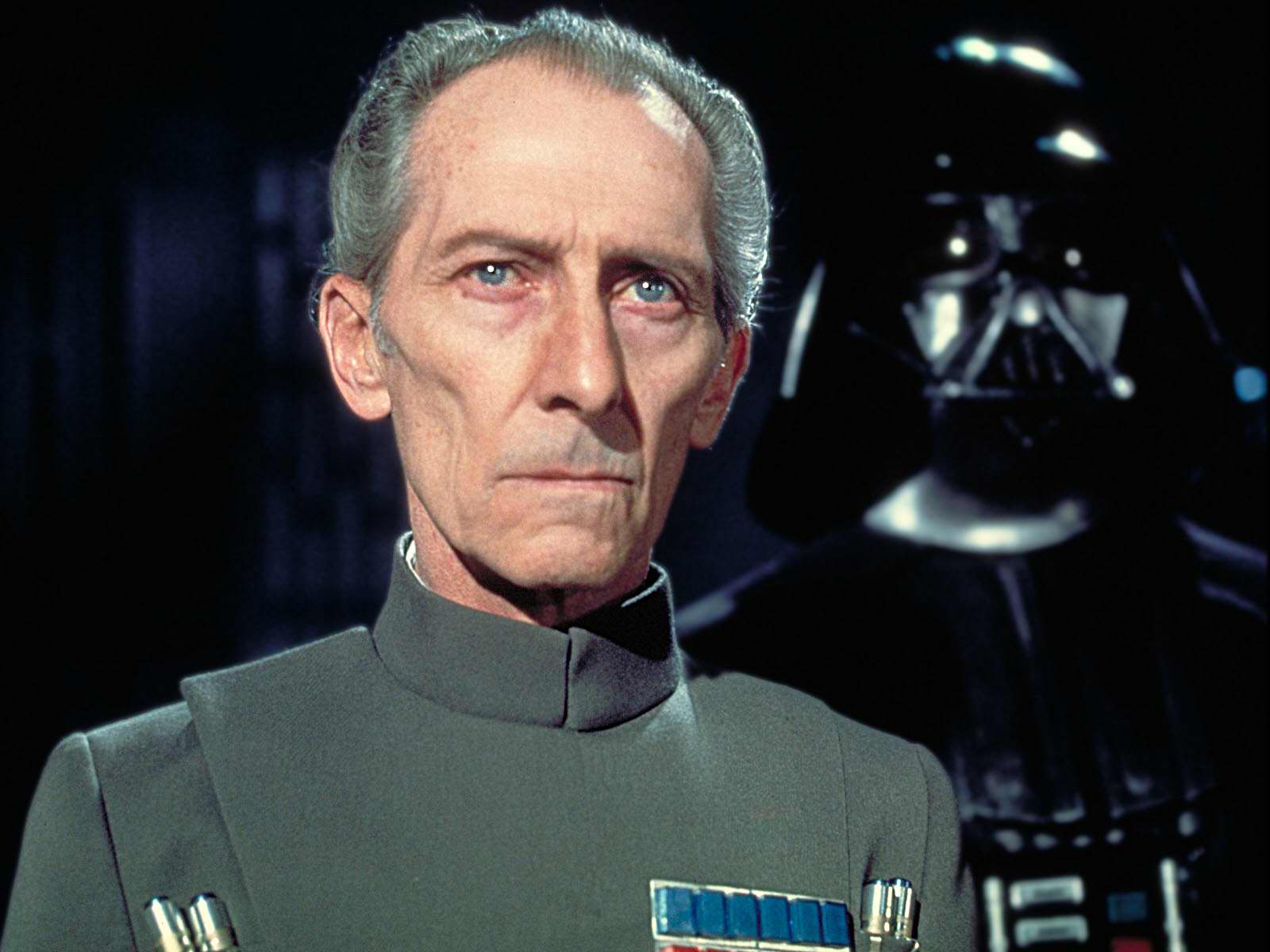
In early 1976, George Lucas, a film director and writer, contacted Cushing with the intention of casting him in his upcoming space fantasy film, Star Wars. Because the film's main antagonist, Darth Vader, who was played by David Prowse, wore a mask throughout the entire film and his face was never seen, Lucas believed it was important to have a strong human villain character. This led Lucas to expand the role of Grand Moff Tarkin, a high-ranking Imperial governor and commander of the planet-destroying battlestation known as the Death Star. Lucas felt that a talented actor was needed for the role and was inspired to choose Cushing after seeing a photograph of him and Lee at the Hammer Film studios headquarters, which were located in the same building as Lucas's office. It was later suggested that Lucas cast Cushing because of his resemblance to Charles Middleton, who played the villainous Emperor Ming in the Flash Gordon serials of the 1930s that inspired Lucas to create Star Wars.
Lucas said that Peter Cushing was his first choice to play Tarkin. However, Cushing later claimed that Lucas initially wanted him to play the Jedi Master Obi-Wan Kenobi and only decided to cast him as Tarkin after they met. Cushing mentioned that he would have preferred to play Kenobi rather than Tarkin, but he was unable to do so because he was working on another film when Star Wars was being filmed. Tarkin's scenes required less filming time compared to the larger role of Kenobi, which Alec Guinness took on. Cushing compared the film to Doctor Who and accepted the part because his criteria for choosing roles was based on what he believed his audience, especially children, would enjoy watching. Cushing was in his sixties when filming took place, and he was flattered to learn that he was still wanted as an actor.
Along with Guinness, Cushing was one of the most famous actors to appear in Star Wars at the time, as the rest of the cast was still relatively unknown. As a result, Cushing was paid a higher daily salary than most of his fellow cast members. He earned £2,000 British pound sterling—approximately $3,656 in American dollars at the time—per day, compared to weekly salaries of $1,000 for Mark Hamill (Luke Skywalker), $850 for Carrie Fisher (Leia Organa), and $750 for Harrison Ford (Han Solo).
During rehearsals, Lucas originally planned for Tarkin and Vader to use a large screen displaying computerized architectural representations of hallways to track the locations of the film's protagonists, Luke Skywalker, Han Solo, and Leia Organa. Although the idea was abandoned before filming began, Cushing and Prowse rehearsed those scenes on a set created by computer animation artist Larry Cuba. Like Guinness, Cushing struggled with some of the technical terms in his dialogue and admitted that he did not understand all of the words he was saying. Nevertheless, he worked hard to learn the lines so they would sound natural and his character would appear intelligent and confident. To interpret the villainous role, Cushing relied on Lucas's guidance and his own instincts as an actor.
Cushing felt uncomfortable in his character's uniform and told Lucas that he felt like he looked like a chauffeur. He was given a pair of boots that were far too small for his size twelve feet. This caused him a lot of pain during shooting sessions, but the costume designers did not have enough time to get him another pair. As a result, he asked Lucas to film more close-up shots of him from the waist up, and the director agreed. Cushing wore the only available footwear, a pair of women's slippers, during the scenes where his feet were not visible. When Cushing smoked between shots, he wore a white glove to prevent nicotine stains on his fingers, which would have required the make-up artists to address.
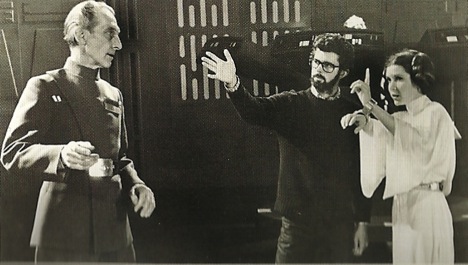
Cushing joined the rest of the cast in May 1976, and his scenes were filmed at Elstree Studios in Borehamwood, England, over a period of two weeks. On April 29, May 3, and May 4, Cushing filmed the scene of the destruction of Alderaan with Fisher, which was set in the Death Star control room and served as her first major dialogue in the film. Cushing consciously tried to define their characters as opposite representations of good and evil, and he purposely stood in the shadows to allow the light to shine on Fisher's face. He mentored Fisher, who was in her first major film role, by providing advice and explaining what to avoid in filmmaking. According to Richard LeParmentier, who played General Motti, Fisher would often try to provoke Cushing with humor, which contributed to the positive shooting environment.
To portray the hatred that Organa's character had for Tarkin, Fisher tried to imagine Cushing as a different person, as she liked him so much that she found it difficult to perform that emotion. Although one of Fisher's lines refers to Tarkin's "foul stench," she said that the actual actor smelled like "linen and lavender," which Cushing attributed to his habit of thoroughly washing and brushing his teeth before filming because he was self-conscious about bad breath. After learning about that line, Cushing asked Lucas, "Do you want me to look as if I have body odor?"
During the filming of a boardroom meeting scene between Imperial officers on May 3, the other actors, including Don Henderson as Cassio Tagge, found it difficult to focus on Cushing's villainous performance because of the slippers he was wearing. The actors had to suppress their laughter while looking Cushing in the eyes, which caused him some concern as he was unsure of what he was doing wrong. After the scene was completed, the other actors told Cushing about the difficulty they had experienced, which made him laugh loudly. Cushing found it challenging to work with the significant level of special effects in the film, as he felt it somewhat undermined the effort that actors put into learning their lines.
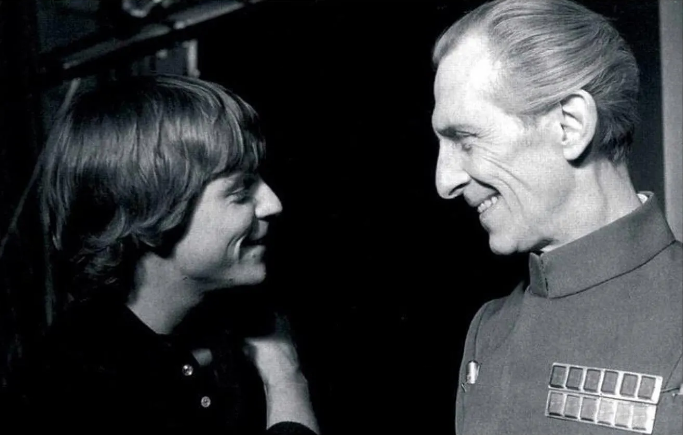
Cushing enjoyed working with Prowse again, as they had previously worked together in the 1974 film Frankenstein and the Monster from Hell, where Prowse had played Frankenstein's monster. Cushing commented that Prowse's costume was much more intimidating than his monster costume, which he described as merely a "bald cap and a diaper." Despite his character's cruel nature, Cushing was highly regarded by his coworkers, who remembered him as a "sweetheart" (according to Fisher) and as an old-fashioned, charming, and humorous gentleman (according to Henderson). He, in turn, liked the environment on set, admiring the professionalism of his younger co-stars and appreciating Lucas's respectful demeanor, which he had not expected from a young filmmaker.
Mark Hamill was disappointed when he realized that he had no scenes with Cushing, as he was a fan of his. Therefore, he visited the set on a day off to meet him and ask for an autograph. Hamill asked questions about Cushing's past acting career, specifically what it was like to work with the comedy duo Laurel and Hardy in the 1940 film A Chump at Oxford. Cushing was surprised that Hamill had even heard of the film. Lucas found Cushing very pleasant to work with, which led the director to continue casting British actors who could play larger-than-life villains in his films.
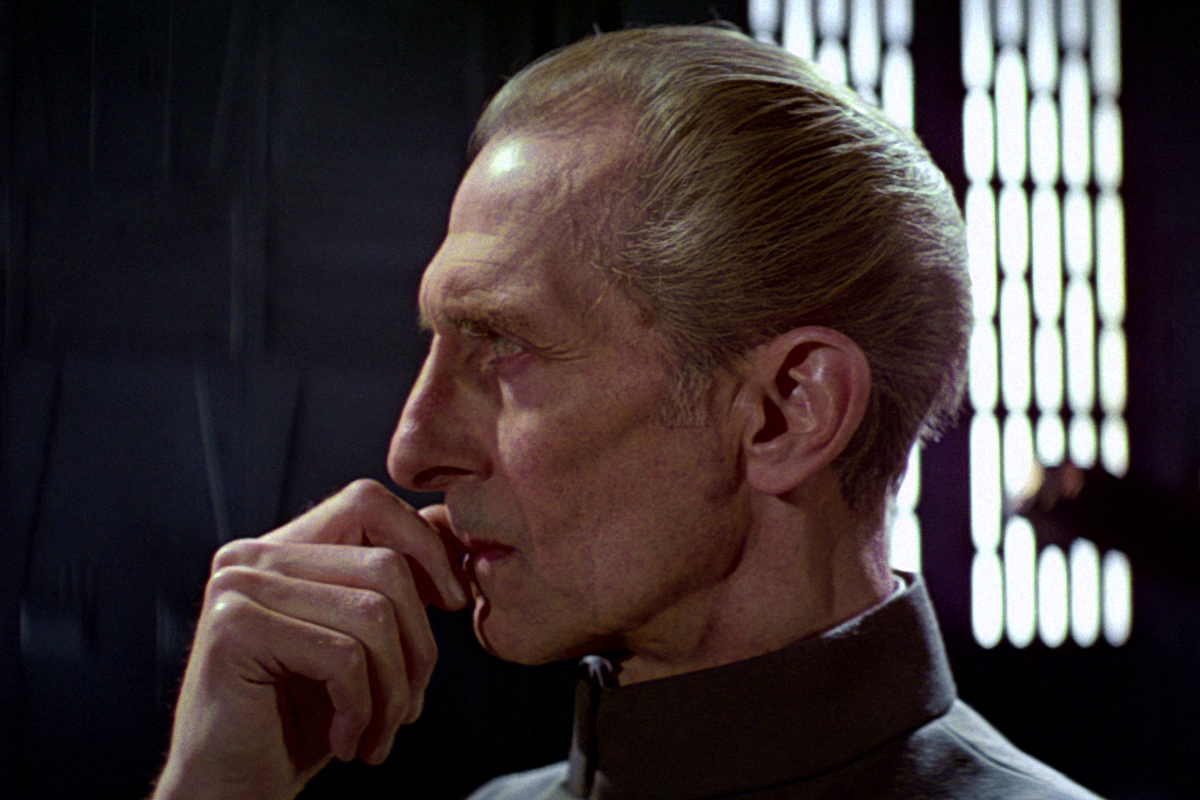
According to Rick McCallum, the producer of the special editions of the original Star Wars trilogy, every scene that Cushing filmed was included in the final film. Additionally, the close-up shots of Cushing aboard the Death Star, shown right before the battlestation is destroyed, were actually extra footage taken from previously shot scenes with Cushing that had been shortened. During production, Lucas decided to add those shots, along with second unit footage of the Death Star gunners preparing to fire, to add more suspense to the film's space battle scenes. Cushing's role as Tarkin was first publicly revealed in a promotional piece published in the Daily Variety magazine on June 15, 1976. Due to Cushing's fame in the Hammer horror films, the piece and other promotional materials presented him as the main villain, rather than Vader.
Star Wars premiered on May 25, 1977, and became a global phenomenon and the highest-grossing film at that time. Cushing was very pleased with the final film and proud of its success. He mentioned that his only disappointment was that Tarkin was killed and could not appear in the subsequent sequels. He believed that his own performance was only passable at best, given that he found it difficult to watch and evaluate his own work. Christopher Lee wrote Cushing a letter asking him about the film, including a question about what a Grand Moff was, to which Cushing admitted that he still had no idea. For his performance, Cushing was nominated for the Saturn Award for Best Supporting Actor at the 5th Saturn Awards, which were conducted by the Academy of Science Fiction, Fantasy and Horror Films. However, Cushing did not win the award, which went to his co-star Guinness instead.
Around July 1985, Cushing participated in a long interview with the magazine Starlog, where he reflected on his career, including Star Wars. In the interview, Cushing rejected complaints made by Prowse that the supporting actors in Star Wars were not fairly compensated, considering that Hamill, Fisher, Ford, and Guinness received large bonuses after the film's huge success. Cushing felt that his original payment was appropriate and was still surprised to receive a "token bonus." In January 1989, Cushing was appointed as an Officer of the Order of the British Empire by Queen Elizabeth II for his contributions to the film industry.
Cushing passed away in Canterbury, Kent, England, on August 11, 1994, at the age of eighty-one. The twenty-fourth issue of the magazine Star Wars Insider, which was released in late 1995, included a tribute to him by writer Jamie Painter that mentioned his extensive career.
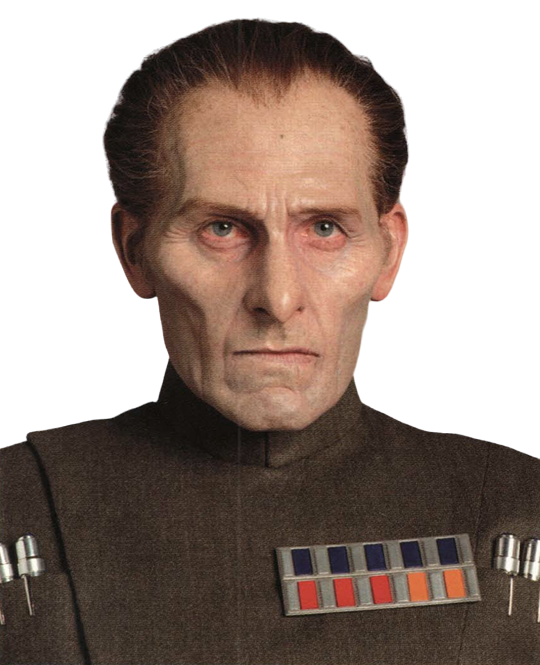
While working on the prequel trilogy film Star Wars: Episode II Attack of the Clones and creating the character of Count Dooku, Lucas realized that he wanted another gentlemanly and aristocratic actor similar to Cushing. As a result, he offered the role to Christopher Lee, who was happy to accept it because of his friendship with Cushing. His casting was announced on StarWars.com on July 11, 2000, and Attack of the Clones was released in 2002.
Lee also appeared in the third film of the trilogy, Star Wars: Episode III Revenge of the Sith, which included a brief appearance by Tarkin at the end. Lucas and producer Rick McCallum initially wanted to recreate Cushing's likeness using computer-generated imagery or by using his younger appearance from a Frankenstein film. They also considered using unused footage from Star Wars and digitally animating Cushing's lips to match new dialogue. Special effects artist Rob Coleman was concerned about the idea of digitally recreating Cushing and discussed it at length with Lee because of his friendship with Cushing. Instead, makeup artist Dave Elsey suggested that Tarkin be played by an actor wearing makeup, and he recommended Wayne Pygram for the part because of his initial resemblance and ability to imitate Cushing's mannerisms. Pygram's initial makeup tests included prosthetics for his chin, cheeks, and nose. After their demonstration, Lucas and McCallum agreed with their solution and contacted Cushing's estate to make the necessary arrangements. At one point during production, Elsey applied makeup for actor Ian McDiarmid while they watched Cushing's Sherlock Holmes television series. Lee happened to visit while they were watching the series, which excited Elsey as he was a fan of Cushing's work.
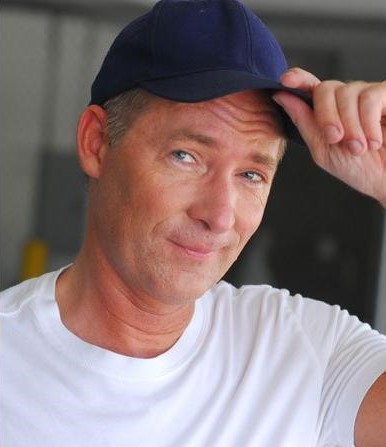
Beginning in 2011, Tarkin also appeared in the animated television series Star Wars: The Clone Wars. The character was designed by sculptor Darren Marshall, who based him on Cushing's image. Marshall mentioned that he grew up watching the Hammer films and admired the talents and expressive faces of both Cushing and Lee. After getting the opportunity to audition, voice actor Stephen Stanton realized that the creators were looking for someone who sounded like a younger Cushing. Therefore, he rewatched several of Cushing's projects, including the 1966 film Island of Terror, and the Sherlock Holmes television series. He also watched Cushing's Doctor Who films on the recommendation of The Clone Wars showrunner Dave Filoni, not initially realizing that Cushing was already playing an older character. Stanton aimed to match Cushing's cadence in rolling his Rs and hoped to combine Cushing's ruthless portrayal of Tarkin with a younger man's energy.
For further research, Stanton read Cushing's autobiographies and listened to Cushing's audiobook versions of them. Since Cushing was already middle-aged when his film career became successful, Stanton had to imagine what his mid-30s self would have sounded like. Stanton felt nervous about taking on the role, considering the iconic status of both Cushing and Tarkin. Stanton reprised the role in the animated series Star Wars Rebels and was able to match his voice more closely to Cushing's performance in the original Star Wars film, given that the show's timeline was closer to the events of that film.
Following The Walt Disney Company's acquisition of the Star Wars franchise, a novel titled Tarkin by James Luceno was announced, to be published by Del Rey on November 4, 2014. Luceno grew up watching Cushing's Hammer horror films and watched several films starring the actor, including Frankenstein, Doctor Who, and Sherlock Holmes, as he wanted to capture a sense of Cushing's line delivery. One line of dialogue from the novel included Tarkin expressing his desire for a uniform and a pair of boots that fit. Luceno enjoyed writing a scene where Tarkin and Dooku met each other, finding it enjoyable to visualize Cushing and Lee acting alongside each other within Star Wars as they had done in the Hammer horror films.
During the production of the 2016 film Rogue One: A Star Wars Story, which tells the story of the theft of the Death Star plans that occurred shortly before the events of the original Star Wars film, the film's writers realized that Tarkin was a crucial character for their film's story. Director Gareth Edwards approached Industrial Light & Magic (ILM) lead John Knoll to ask if the idea of digitally recreating Cushing's likeness was unreasonable. Knoll responded that the company's purpose was to push the boundaries of visual effects forward. The filmmakers obtained permission from Cushing's estate to use his likeness.
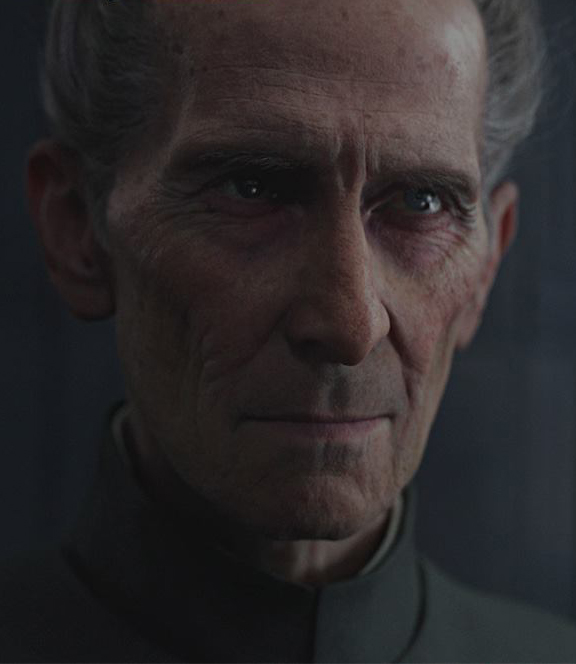
The role of Grand Moff Tarkin was offered to actor Guy Henry after casting director Jina Jay sent director Edwards a video clip of him, pointing out similarities between Henry's mannerisms and those of Cushing. Early in his career, Henry had portrayed Sherlock Holmes and had carefully studied Cushing's performance as the same character, acknowledging Cushing as a major influence on his acting. Edwards contacted Henry about the role, understanding it was unusual to ask an actor to have his performance visually replaced by another actor's likeness. Henry accepted because of Cushing's significant impact on his career, stating he would have declined if asked to impersonate any other actor.
To faithfully replicate Cushing's performance, Henry repeatedly watched Cushing's scenes, focusing on mimicking his voice, especially the rolled Rs. Before each scene, Henry would recite Tarkin's line, "You would prefer another target, a military target?" from the original Star Wars to get into character. Henry found the process challenging, feeling the pressure to honor Cushing's legacy. Edwards, in his direction, suggested Henry could incorporate more of his own acting style rather than strictly imitating Cushing. Henry even proposed that impressionist Rory Bremner might be a better choice, but Edwards and Lucasfilm were firm in their decision to keep Henry.
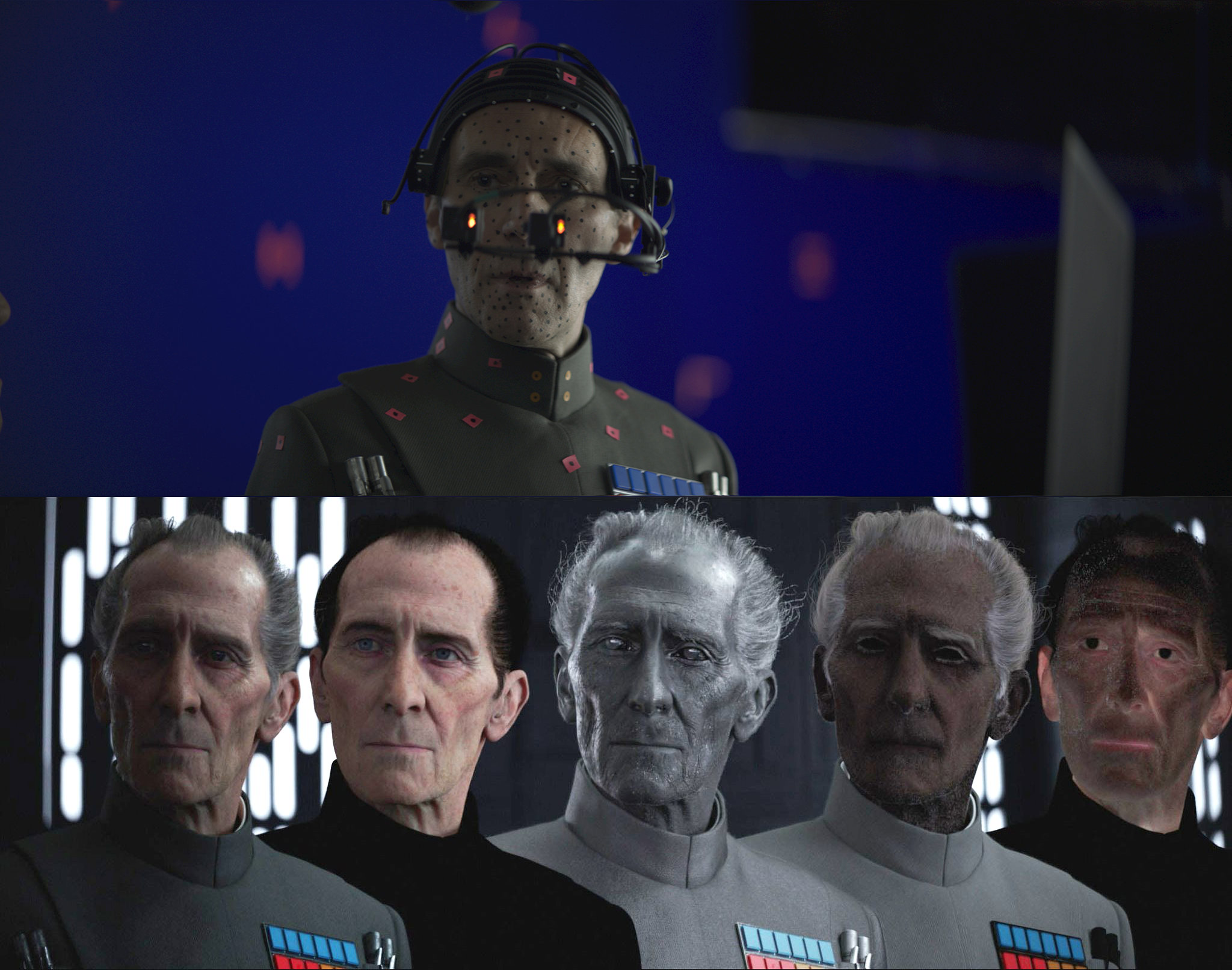
In preparation for digitally recreating Cushing, the visual effects team at ILM meticulously reviewed Tarkin's scenes from the original film, constantly referencing them during the production process. John Knoll also located a life cast of Cushing that had been made for his role in the 1984 movie Top Secret!, which was digitally scanned to provide a reference for Cushing's facial features from around the time of 1977's Star Wars. Henry wore motion capture technology during filming, which enabled ILM to make detailed, frame-by-frame adjustments to more closely match the Cushing simulations as needed. Adjustments were also required to compensate for differences in the lighting between Rogue One and Star Wars. The effects were refined over an eighteen-month period, even though Edwards and the team were uncertain if the visual effects would be successful. Backup plans were considered in case the effects were not satisfactory, such as depicting Tarkin as a hologram or transferring his dialogue to other characters. The team only gained confidence in their success in the week leading up to the film's 2016 release.
The promotional material for the film did not explicitly reveal Tarkin's appearance, although there were rumored leaks in the media about Cushing's digital recreation. Some TV spots offered brief glimpses of the character. Upon the film's debut, Edwards expressed surprise that audiences were not anticipating the character's presence. The film's credits included a special acknowledgement to Cushing for the use of his likeness.
Joyce Brighton, Cushing's former secretary and the executor of his estate, was astounded by the digital effects, but she was unable to discuss the specifics of the confidential agreement between the estate and Lucasfilm. The deceased actor's appearance in the film sparked discussion and debate in media outlets about the ethical implications of using an actor's likeness without their physical presence. Knoll defended the recreation, stating it was done with great respect and care, which he believed Cushing would have appreciated, and that the team had not done anything Cushing would have disapproved of. Henry himself expressed relief with the final appearance of the character and stated he would gladly play the role again if asked.
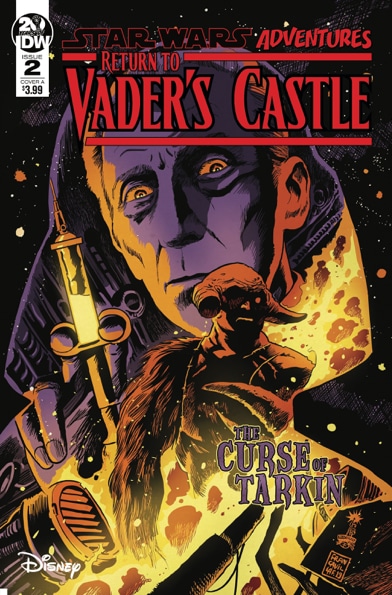
In 2017, Michael Siglain, the creative director of Lucasfilm Publishing, and author Cavan Scott discussed the connections between Star Wars and their favorite horror films, particularly the Hammer productions featuring Cushing and Lee. They explored how these stories could be creatively adapted into the Star Wars universe, imagining scenarios such as Tarkin as Dr. Frankenstein or linking Tarkin and Dooku in a narrative. This brainstorming led to the idea of Tarkin creating a clone of Dooku. This concept evolved into the miniseries Star Wars Adventures: Return to Vader's Castle, which was structured with multiple stories of varying tones and monsters connected by a central character, inspired by the Cushing/Lee film Dr. Terror's House of Horrors.
Scott's story centered around Tarkin was the second issue of the series, released by IDW Publishing on October 9, 2019. The plot, titled "The Curse of Tarkin," depicts the Grand Moff fighting against an experimental creature of his own creation seeking revenge, mirroring the plot of Mary Shelley's novel Frankenstein. The comic also featured a Lambda-class T4-a shuttle used by Tarkin called PC-265, whose name used Cushing's initials and referenced his birthdate of May 26. Scott again drew inspiration from Cushing's horror films for his comic story "The Haunting of Grand Moff Tarkin," included in the Tales from the Death Star anthology published by Dark Horse Comics on October 17, 2023.
Giancarlo Esposito drew inspiration from Cushing's performance as a fellow Moff when preparing for his role as Moff Gideon in the television series The Mandalorian. Gideon first appeared in the seventh episode of the series' first season, which premiered on Disney+ on December 18, 2019. Similarly, during the filming of the sequel trilogy film Star Wars: Episode IX The Rise of Skywalker, which premiered on December 20 of that year, actor Richard E. Grant based his portrayal of Allegiant General Enric Pryde on Cushing's depiction of Tarkin.